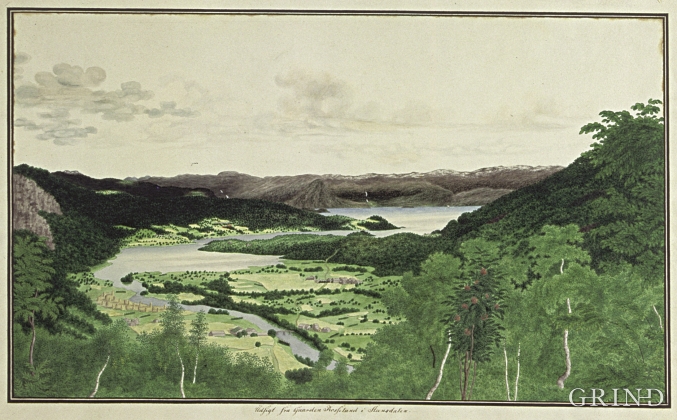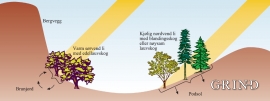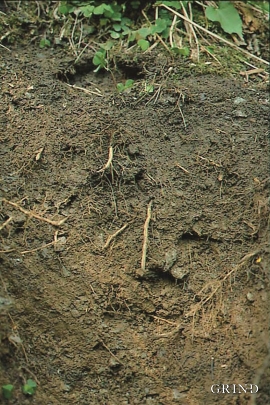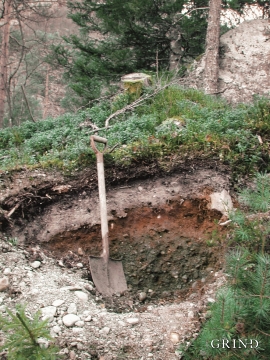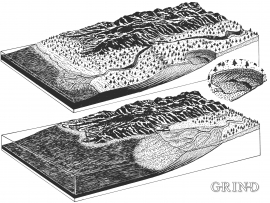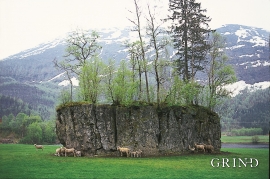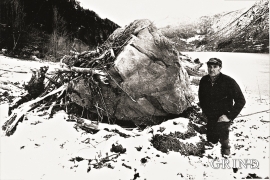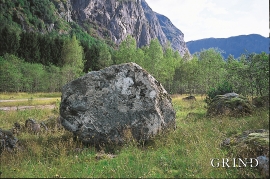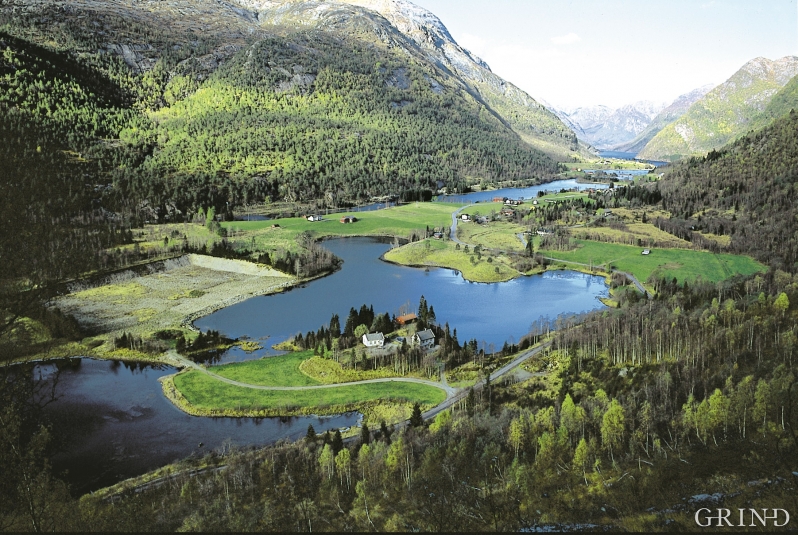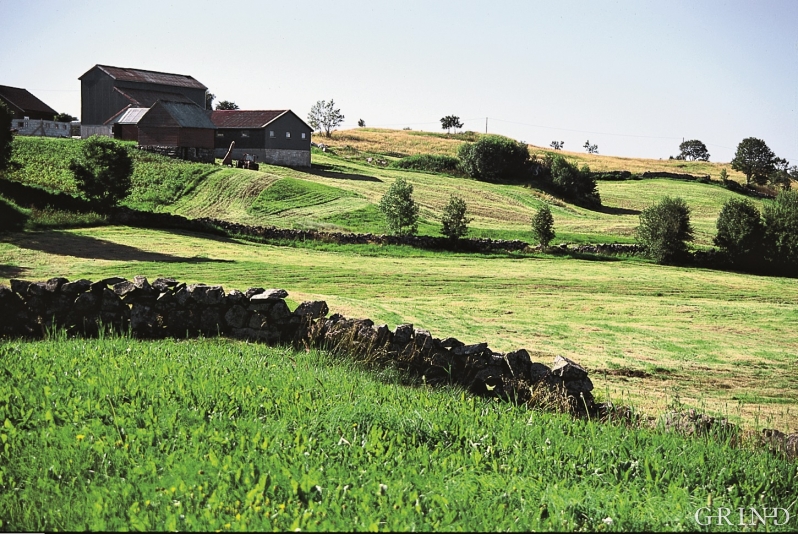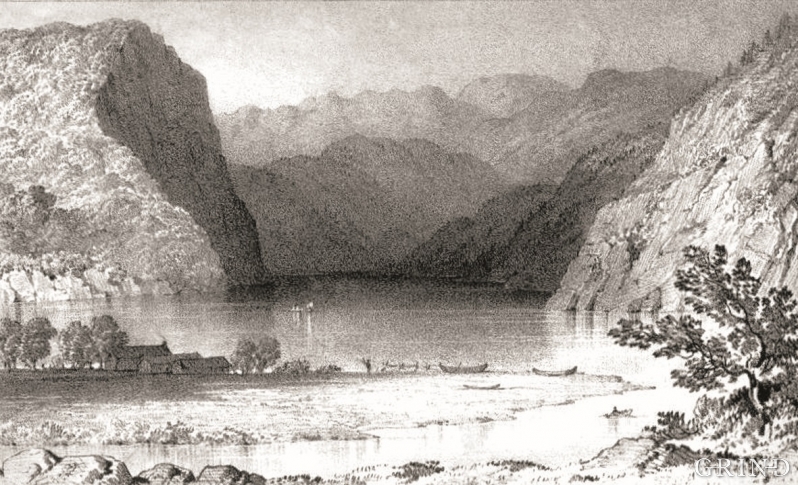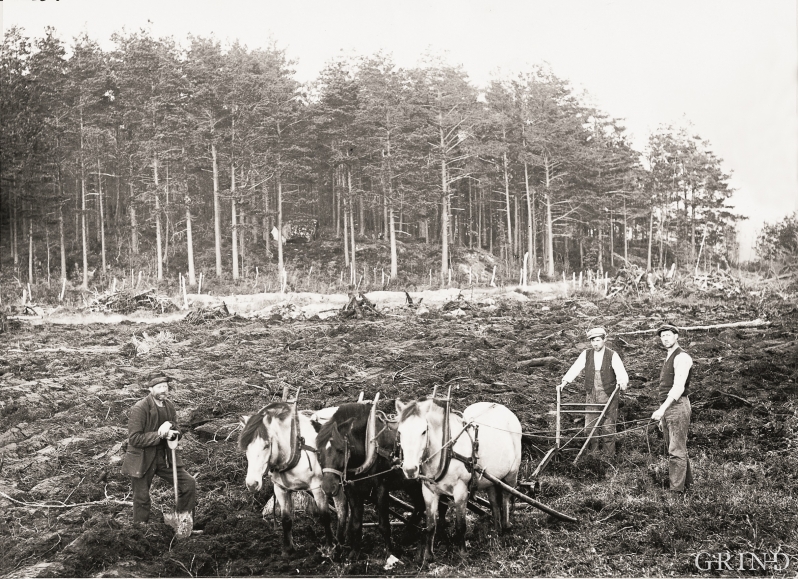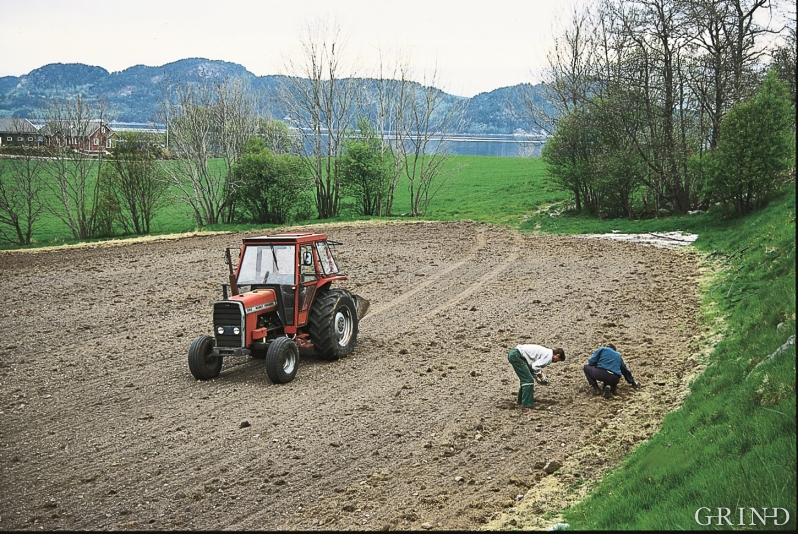Published: 27.05.2019 | Author: Inge Aarseth
Steinsdalen i Kvam i Catharina Kølles (1788–1859) strek. Noko av den beste jorda i fylket finst i denne dalen.
"Humus" is a word with great meaning. It is the soil we live from, in addition to the resources we get from the ocean. This layer of earth - sometimes appearing as loose fertile organic matter; other places as scanty and acidic soil - is found in varying thicknesses over the bedrock. It is the result of 10,000 years of breakdown and erosion following the last ice age, and then several thousand years of cultivation in more recent times. The soil we can buy at the garden centre is a different product than the "natural" humus layer, formed of processes occurring far under the earth's surface. If you dig your spade into the soil where it has not been ploughed before, you will see that there is a big difference in colour, soil structure, moisture and stone content. We might say that the soil is fertile and easily worked some places, whereas other places folk might have given up trying to grow anything on their small patches of land, which then become overgrown with birch and thicket. Modern agriculture does not have room for small stumps between the piles of stone. Nowadays, machines do the job, and they require a lot of space and flat ground.
There is much variation in the natural conditions in Hordaland. The bedrock changes from acidic quartzite to calcium-rich shale, and this strongly influences the soil. The amount of precipitation varies also, such that the sandy soil furthest in toward the fjords must be watered in summer, whereas other areas get so much rain that good drainage is necessary to prevent the soil from becoming waterlogged. The upper layer of soil, where the plants put down their roots, has been influenced by the climate variations between summer and winter and by plant and animal growth, for thousands and thousands of years since the ice left behind its gravel, sand and clay.
Moraine soil
The continental ice sheet removed most of the soil that existed prior to the last ice age (*p. T68). When the ice melted at the end of the last ice age, roughly 11,000 years ago, it left loose deposits that either had been laid down under the glacier - as what is called a "ground moraine", or along the edge of the ice, as what we call en "end moraine". Moraine material is formed under glaciers, which break loose pieces of bedrock and grind them down to smaller pieces due to the great pressure of the ice. The resulting stones freeze into the sole of the glacier and scour the bedrock further, like a large piece of sandpaper, and this gives fine-grained material. Moraine soil therefore has many different grain sizes mixed together: stone, gravel, sand and a little silt (coarse clay). Moraine soil that overlies mica schist can also have a bit of clay particles, but seldom so much clay that it prevents rainwater from seeping down into the earth. The thickest layer of moraine soil is normally found in valleys that lay perpendicular to the glacier movement. When the glacier was at its maximum, it could move right across side-valleys because the ice mass would always move in the direction the surface was tilted toward, even if this meant uphill.
We find such moraine deposits on the slope below Bavalen and down toward Ringheim at Voss or along the fjord from Rosendal to Uskedal, where thick moraine soils reach high up on the slopes. In Våkendalen above Svartediket in Bergen, there are several farms with thick, stony moraine soil. Other places, end moraines were deposited where the edge of the glacier stopped for a time, as for example south and east of Fitjar centre (*p. R287). The material was transported under the glacier somewhat like a reverse "conveyor belt", with ice edge marking the end of the transport and thus the spot where the end moraine was deposited. Moraine material tends to be transported only a short distance from where it was scraped up by the glacier. Therefore it tends to have the same mineral composition as the underlying bedrock. Gneiss or granite usually do not get ground down to particles finer than sand, while moraine soils from mica schist or phyllite contain much fine-grained material. These have small flakes of mica that contain potassium, which makes the soil nutrient-rich. The moraine soils of phyllite at Voss or in Steinsdalen in Kvam are some of the best soils in the municipality. Otherwise, one also finds thick layers of moraine soil in many of the mountain valleys, and it was here, on these soils, that mountain farms were built in the olden days. Moraine soil is often stony, so working such soils has always been challenging.
(*p. R235).
Deposits of glacial rivers and in the sea
Toward the end of the ice age when average temperatures began to rise, rivers flowed under the glacier and carved into the moraine material, taking some of it along, usually all the way to the front of the glacier. If the glacier ended on land, the coarsest material was deposited on large glacial river plains, or "outwash plains", as geologists call them. Bømoen at Voss is the largest area with an earlier outwash plain in Hordaland (*p. R450), but several others are found above Hellandsfossen in Modalen and from Eikemo and upwards in Eksingedalen (*p. R435). If the edge of the glacier rested in the sea, ice-margin deltas of sand and gravel would be laid down. After the land rebounded when the weight of the ice was lifted, these delta flats would become wide terraces which now are usually cultivated. The largest of these is found in Etne, which has the greatest continuous agricultural area in the municipality (*p. R242). Sandy soil is easily cultivated, but much of the nutrient-rich finer-grained minerals has been washed out by glacial rivers. Some of these are to be found in the clay deposits that got transported out to sea and laid down in deeper waters. After the land rebounded some of these clay deposits are now above sea level and make up large areas of clayey soil. There is much clay just outside of the "Herdla moraine" which was deposited at the end of the last ice age.
Leirvik at Stord (*p. R276), Vinnesleiera in Fusa (*p. R322) and Leirvåg in Austrheim (*p. R396) lie on clay, as their names indicate (leire = clay in Norwegian). In addition, there is clay and silt on the slopes above the river plain in Etne (*p.ingen oppgitt i boka, s. 76 3. kolonne) and along the lower part of the river Oselva.
River plains and deltas
The valley bottoms of Hordaland today have relatively small river plains, while the terraces on the sides were continuous deltas or river plains when the sea level was higher. As the land rebounded after the ice age, the rivers carved down through the ice edge deposits and carried stones, gravel and sand out into the fjords, steadily lowering these delta flats. The soils on the river plains and terraces are "scanty" and porous with sand and gravel which makes them prone to drying out. In inner regions, with relatively little precipitation, such as in Eidfjord, this type of soil sometimes requires additional watering in addition to much fertilizer. The soils on the river plains can be vulnerable to flooding. When the river floods over, it causes both erosion and deposition. When rivers carve away on flat land, the hydrodynamics causes large bends, called meanders, named after one of the most characteristic border patterns from Classical Greece, meander. The rivers of West Norway fall relatively steeply and are very vulnerable to erosion; therefore, flood protection has been erected in the outer bends some places, where the river carves most ravenously, as can be seen for example along the rivers Etneelva and Moelva.
Where the rivers run out into lakes, deltas are also formed. Roots here have a short distance down to the groundwater. If the outlet from the lake is narrow, the delta flats will be vulnerable to flooding, and therefore the outlet threshold has been lowered some places, as in Lake Vangsvatnet and Lake Myrkdalsvatnet in Voss. In Myrkdalen, the 2,400 acre-large delta area floods annually, usually both in spring and autumn. The lake has been tapped, but regulations are now reduced and this has provided good conditions for both farmers and birds. Further down in the water system, Løneøyrane is a relatively large untouched delta area out in Lake Lønavatnet.
The littoral zone and tides
We tend to find beach deposits where waves and currents have been able to work away at the loose deposits that were deposited at the end of the last ice age. Tidal currents have been active in some of the fjord landscapes, such as at the mouth of Mofjorden (Mostraumen *p. R426) and at Bolstadfjorden. Between Straume and Stamneshella, tidal flats have built up. Tidal flats are also found in protected bays where the energy from the waves is small, as at Vinnesleira in Fusa (*p. R322) or in Osen and Ølensvåg in Ølen. At such places there is soft organic matter and it is teeming with life, both down in the deposits; the sediment, and from the myriad of bird species that live on these organisms. The tides have also created one of the largest flat agricultural areas in Hordaland: at Herdla (*p. R350). Here, the currents between Hjeltefjorden and Herdlefjorden formed the flat Valen before the land rebounded to up above sea level two- to three thousand years ago.
Weathering soils
Weathering soils is the name given to the soil type that is created when the bedrock crumbles away to become soil. There is much variation in how quickly bedrock weathers. Gneiss and granite, containing light minerals such as quartz and feldspar, weather slowly and give nutrient-poor soil, while bedrock containing darker minerals, like amphibole (amphibolite) and mica (phyllite) weather more easily. In addition to the mineral content, the density and abundance of cracks in the bedrock are important. During cold periods frost weathering can cause bedrock to break up along cracks. If there are many cracks over a large surface area, wind and weather more easily come into direct contact with the minerals. By wind and weather we mean temperature, air currents, precipitation and gasses that are dissolved in the rainwater.
When plant remains on the ground get broken down by microorganisms, carbon dioxide (CO2) is also produced, which when dissolved in water produces carbonic acid (H2 CO3 ). Even though the acid is weak, it will react with the minerals in the bedrock and dissolve or alter them. Limestone or marble contain the mineral calcite (CaCO3 ) which dissolves to give off ions of calcium (Ca), *p. R295, while feldspar, for example, will be altered to clay minerals such as illite or chlorite which give off ions of potassium (K). Both of these elements are very important for plant growth. Weathering soils are found especially in areas with mica schist, such as along the mountain farms at Stord. Inward along Hardangerfjorden there is much weathering soil, both in Strandebarm and in Steinsdalen in Kvam.
The so-called "Bergen Arcs" (*p. R337) also contain zones of mica schist. This has yielded good weathering soils in many places, as at Ask with its well known strawberry fields (*p. R354), or at Os and Osterøy. The amphibolite-rich gneiss at Lygra in Lindås has yielded sandy weathering soil that is up to a metre thick in places.
Organic soil
Organic soil is soil that has been created from the alteration of plant remains or shell sand. Soil from plant remains makes peat soil, which is often found in areas with poor drainage. The high groundwater levels in flat clayey areas cause moss to accumulate in thick layers. The moss is eventually transformed, so that the clay gets covered by peat. We see this several places such as at Fosenøy in Austrheim and Vinnesleira in Fusa. If we drain the water in peat bogs overlying clay, we get a good and easily-worked soil that does not clump together as much as peat soils overlying bedrock. With the levels of precipitation we have in West Norway, peat soils are common both in the strand flat zone along the coast, such as the large areas covering the bogs at Fedje, and in the alpine areas in Stølsheimen, around Lake Hamlagrøvatnet or at Kvamskogen. In central regions of the municipality there is so much rain that bogs form on the hill sides also, forming so-called "blanket bogs". Many bogs are the result of small ponds or lakes naturally becoming overgrown.
Shell sand is another organic soil type that is found in small valleys in the outer districts, especially in Øygarden (*p. R375), but also in smaller areas on Sotra, Austeoll, Bømlo and Sveio. After it became ice-free along the coast roughly 14,000 years ago, shells accumulated in areas with shallow water. The sea level in these areas then was roughly 20-40 m higher than today. Shells were washed down into small depressions that now are found up on land. Shell sand has since been overlain by a thin layer of peat, and this soil is especially fertile because of its calcium content, but such areas are small in Hordaland.
Avalanche soils
When we talk of avalanche soils, we think of stone fans that are the result of landslides. Many places in Hordaland the earth is disturbed and transported by other types of slides. Usually, high amounts of precipitation in the form of rain, together with melting snow, is the triggering mechanism. On steep slopes this can give landslides, snow avalanches or debris flows. Waterlogged soil can race down slopes, follow stream beds down to flatter ground where the flowing masses spread out and get deposited as river fans, such as we can see at Unneland in Arna.
Avalanche soils are found in or just below most steep slopes, but it is in Hardanger, and especially on the hill sides on both sides of Sørfjord, that they are most abundant. Here, there are many avalanche runs that have transported earth from the mountains down to less steeply-sloping ground. The slides carry mineral-rich soils out over the fields, but this is seldom welcome in modern times. The avalanche soils that already have been deposited nonetheless give good growing soil for the fruit farmers of inner Hardanger.
Frost phenomena in alpine soils
The soils of the high mountains are influenced by frost, and this causes the formation of peculiar patterns on the surface. Stones freeze upwards and collect in rings (stone polygons). In steep terrain stone stripes form and creep downwards, especially during the thaw period, when the upper layer of earth is waterlogged because the ice deeper down blocks the downward seepage of water. If the slope is covered by grassy vegetation, it will form so-called "solifluction tongues" which are banks of soil that creep slowly downwards a bit like a carpet that rolls over itself. Such forms are common in phyllite areas on plateaus higher than 11-1200 metres above sea level, as we can observe on the slopes around Finse (*p. 467)
So we see that the ground and soils are not a permanent part of the landscape because even if they are not disturbed by humans, they participate in larger and often complex natural processes.
Processes in the soil
Humus is that part of the soil that has been influenced by the climate and a variety of organisms. Humus develops over a long time-span, and under the climatic and topographic conditions at a given locality. Since we receive much precipitation in Hordaland we should be glad that the terrain for the most part has good drainage, otherwise we would have peat nearly everywhere. It is the physical, chemical and biological conditions that determine what type of soil develops. We know that there are different types of organisms living in the earth, and we should be grateful when the earthworm helps to work the soil for us.
In addition, frost helps to move stone up to the surface when the ground freezes. We think less about the kind of work micro-organisms carry out. There are many different species of microbes, plants, fungi and bacteria living under the earth's surface. The top layer consists of humus (dead plant remains). If the humus has enough airspace, it will be broken down through what we call "oxidation", roughly as when we compost. It is mainly the chlorophyll-free plants (fungi and bacteria) that do this work. Then what happens is the opposite of photosynthesis, since micro-organisms transform carbon (C) to CO2 (carbon dioxide). The amount of CO2 in the humus layer can be 200 times that in the air. Similarly as in the processes creating "weathering soils", carbonic acid (H2 CO3 ) is formed also here, and this, together with the humic acid and other acids created by organisms, seeps down to the upper part of the mineral-soil. At this level there is active chemical leaching and alteration of a number of minerals that contain the elements iron, manganese, and others. One will see a lighter layer that we call the "leached horizon", where the darker minerals have been altered. Just under this layer the solution is deposited and forms a brown precipitation layer, where the minerals grains take on a film of oxides. Iron oxide is in essence the same as "rust", and the minerals seem to have a film of rust. In sandy and gravelly soils this film can bond mineral grains together to form a brown, cement-like layer that we call “hard pan”.
This is how we got podzol, the most common soil type in Hordaland. Podzol is especially common in conifer forests and on nutrient-poor bedrock, and as mentioned we have a lot of that in Hordaland. Decomposition of the fir needles that lie on the forest floor give extra acidic soil and good conditions for the formation of podzol. A good rule says that where there is much blueberry, the soil is podzol. In deciduous forests and on more nutrient-rich bedrock such as phyllite and amphibolite, the soil type might rather be grey-brown podzol. Grey-brown podzol is rich in humus, and has much loose soil in its upper layers. Here, the earthworms are able to mix together the humus layer with the inorganic earth deeper down. Grey-brown podzol does not have the same clear layering that podzol has. In Hordaland grey-brown podzol is restricted to areas with phyllite and amphibolite and is found, for example, in the beech forest at Seim, on Osterøy and Stord, in addition to in Kvam and parts of Voss. Since it takes time to develop a soil, we will only find these soil types in earth that has not been ploughed.
Next time you set your spade in the ground, think of the many complex processes that have laid the foundation for the formation of soil. You might find some earthworms, but there are millions of small organisms and fungi that are doing the heavy work. This happens largely after the geological processes have created the different basic soil types. Pedology, meaning "the study of soils", is a discipline where knowledge both about the geology and chemistry are important. It is the scientific understanding of the many interactions that gives us insight into the fundamental conditions of our ecosystem.
Moraine
Under isbrear vert det avsett botnmorene ved at breen skurar og plukkar steinmateriale frå berget under. Endemorene vert avsett framom breen anten fordi breen skuvar saman lausmassar til ein rygg når han rykkjer fram, eller ved at materiale vert ført fram til fronten langs skjerplan inne i isen når fronten ligg i ro, som på eit transportband. Sidemorenane får det meste av massane frå skred frå dalsidene. Morene har vanlegvis alle kornstorleikar: leire, silt, sand, grus, stein og blokker. (Wojtek Nemec)
Frå istidsdelta til terrasse
Sand og grus vert avsett i eit delta ved slutten av istida med leire på botnen utanfor (teikninga under). På grunn av landhevinga vert det gamle deltaet heva og er no ein terrasse (over). Elva skjer seg ned og dannar eit nytt delta ut i fjorden. Leira i botnlaga er òg heva opp på land – og dei gamle skrå deltalaga kan vi sjå som skrålag i grustak i terrassane. (Wojtek Nemec)
How did these stones get here?
Glacial erratics are the most coarse-grained part of any soil type. If stone blocks lie in strange places, there are often legends associated with them, but geologists can always provide a natural explanation. There are natural forces at work.
A Glacial erratic, continental ice sheet
Timeglaset, Gråsida, Voss: Stone that the ice sheet could no longer carry. A glacial erratic is generally a different type of bedrock than the one it lies upon. The blocks often have somewhat rounded edges.
B Landslide block, rock avalanche
Block on river plain in Eksingedalen. Blocks are often found a short distance from the scree slope that has been formed by a landslide. Large blocks often have more energy than smaller blocks and therefore can roll further. Such blocks are often angular.
C Landslide block, snow avalanche
Block on scree field at Lake Steinslandsvatnet. Especially a wet snow avalanche can carry blocks weighing several hundred kilogrammes and deposit them in a scree fan or scree field (*p. R429). Such blocks are sharply angular.
D Block, catastrophic flood
Block on river plain in Simadalen. When Lake Demmevatnet was emptied during Rembesdalsskåki (*p. R517) and flowed down into Simadalen, the water spread large blocks out over the river plain. Such blocks tend to be rounded.
- Andersen, B. G. 2000. Istider i Norge. Landskap formet av istidens breer. Universitetsforlaget.
- Anundsen, K.; Simonsen, A. 1967. Et preborealt breframstøt på Hardangervidda og i området mellom Bergensbanen og Jotunheimen. UiB Årbok. Mat.nat. serie 7.
- Follestad, B. A. 1972. The deglaciation of the southwestern part of Folgefonn peninsula, Hordaland. Norges Geologiske Undersøkelse 280:31–64.
- Mangerud, J. 1976. Fra istid til nåtid. I: Hartvedt, G. H. (red.). Bygd og by i Norge. Hordaland og Bergen: 111–151.
- Thoresen, M. K.; Lien, R.; Sønstegaard, E.; Aa, A. R. 1995. Hordaland Fylke. Kvartærgeologisk kart 1:250 000. Norges geologiske undersøkelse.
- Aarseth, I.; Mangerud, J. 1974. Younger Dryas end moraines between Hardangerfjorden and Sognefjorden, Western Norway. Boreas 3:3–22.
- Aarseth, I. 1995. Sedimentene på bunnen av fjordene i Vest-Norge. Naturen : 212–219.

